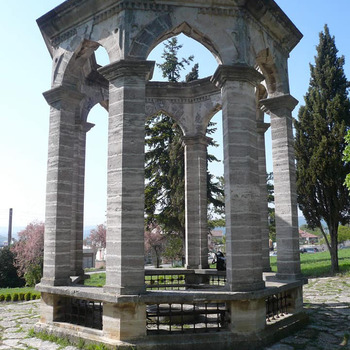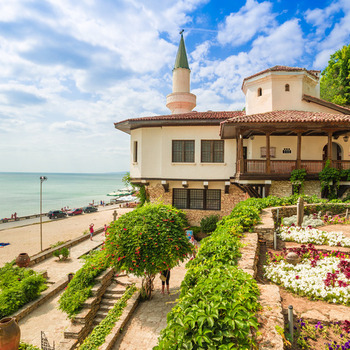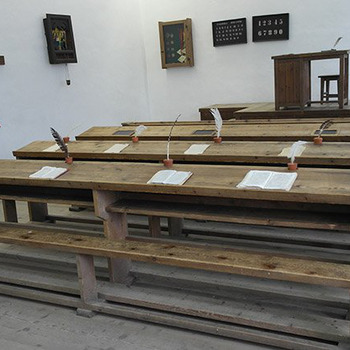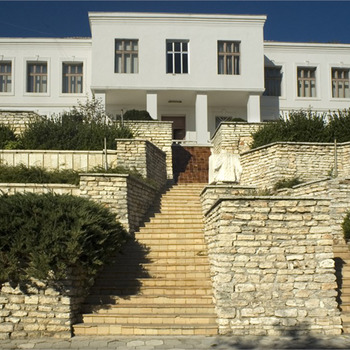Tekke “Ak Yazala baba”
Overview
Tekke “Ak Yazala baba” – the most famous Muslim and Christian sanctuary in the past Bulgarian countries, it is located near the Obrochiste village, not far from the dense forest “Baltata” and the Black Sea coast.
“Except tekke sites of Imams Ali and Hussein in Bgadad there is no place with such a tekke in Turkey, nor in Persian lands” – wrote the famous Ottoman traveler, Evliya Celebi. He has visited this place in 1652. Then Evliya was very ill, but after sleeping overnight at the saint’s tomb, he has been healed immediately. If the praises of this traveler at the monastery near Obrochishte are due miracle made or are sincere praise, is hard to say. But he wrong thing. Not only in other parts of the Ottoman Empire, but also on the Bulgarian lands were similar tekkes. For instance, such tombs are the Osman Baba tomb in the Bogomil village, Haskov; of Demir Baba in Sborianovo, Isperih and of Kademli Baba nearby the Grafitovo village, Nova Zagora. But indeed Dobrogea Dobrogea does not know any such Tekke. Even today it remains the best model of Ottoman architecture and culture on our lands from the early sixteenth century.
Now, from the wide religious past complex are kept only two monumental buildings, isolated one from another, with flat construction but with different sizes – peat, or the saint’s tomb, and Imaret, where Dervishes have performed their ceremonies and welcomed the guests of tekke. It represent a heptagon with rectangular anteroom stuck by one of its sides. In the middle of the peat is the Akyazala Baba tomb, orientated to north-south-west and covered with a green cloth. Once, Besides this, Yak Yazala Baba things were put, which was thought he holds tremendous power. Even today most impressive are the paintings on the walls and peat’s ceilings which represents stylized plant and geometric ornaments in oriental style.
Tekke’s Imaret has dimensions significantly higher and a south entrance. In the past, the main hall ended with a complex woden structure on seven levels, lined with sheets of lead, which was destroyed during the Russian-Turkish wars. In the middle of imaret was a fountain, and at the north end was raised an outdoor fireplace, which ended with a stone chimney with seven walls. It reminds us of a refined body of a minaret. Once over the fireplace, on a thick chain was hanging a huge ship, a symbol of dervish hospitality, who were offering free food and shelter for three days every traveler passing through their lands.
The holy Muslim Yak is Yazala Baba is tomb’s patron, worshiped by locals as an ancient mythical worship hero – healer and wonderworker, lord of the land forces and the bearer of fertility. Actually this aint was a real person. Unlike legens, a few historical sources reached us and represents him as a leader of the Derviș order – Osman baba famous successor, whose peat is situated in the village of Bogomil, Haskovo and Demir Baba’s spiritual mentor, who in his turn, is the Tekke’s patron of Sboryanovo, Isperih.
Except fo the monks, over the centuries the monastery has served as a spiritual center of the local poulation, attracting believers from near and distant parts of the empire. In the second half of the XXth century they started to visit it and the Christians came to this place to honor the popular Saint – Saint Atanasius.
The reasons for developing this double formalism are still unclear, but tekkes’s perception by the local population as a sanctuary, makes possible worship here of the ethno-confessional different groups musulmans (unnis and Shiites) and Christians. Traditionally, those who profess Islam visit the tomb on Monday, Thrusday and Friday when they give oath and Christians – when they need help and protection of their saint. The busiest meetings are meetings on 2nd of May – Athanasius Day adopted as the day of Ziua lui Yak Yazala baba when both Bulgarians and Turks celebrate together. Despite the fact that believers perceive and understand their visit through their ethno-confessional affiliation, at Tekke they perform the same rituals – pray over the saint’s tomb, wash with water, tie pieces of cloth on the branches of the surrounding trees, light candles, leave rich votive offerings. All these rituals associated with life-death position and aiming to the saint protection, in force of whom everybody wholeheartedly belives, are ancient practices inherited from the past that continue to exist even today.
Tekke is Khanqah.
A khanqah (Persian: خانقاه) or khangah (Persian: خانگاه; also transliterated as khankah, khaneqa, khanegah or khaneqah), also known as a ribat (رباط) – among other terms – is a building designed specifically for gatherings of a Sufi brotherhood or tariqa and is a place for spiritual retreat and character reformation. In the past, and to a lesser extent nowadays, they often served as hospices for saliks (Sufi travelers), Murids (initiates) and talibs (Islamic students). Khanqahs are very often found adjoined to dargahs (shrines of Sufi saints) and türbes (tombs of notables), mosques and madrasas (Islamic schools).
In the Arab world, especially North Africa, the khanqah is known as a zāwiyah (Arabic: زاویه, plural zāwiyāt; also transliterated as zawiya, zāwiya or zaouia). In Turkey, Iran and formerly Ottoman areas like Albania and Bosnia and Herzegovina, they are locally referred to as tekije (تكيه; also transliterated as tekke, tekyeh, teqe or takiyah). In South Asia, the words khanqah and dargah are used interchangeably for Sufi shrines. In addition, there are lodges in Central and South Asia often referred to as Qalander Khane that serve as rest houses for the unaffiliated malang, dervishes and fakirs.
Tohidkhaneh, a medieval khanqah in Isfahan, Iran.
Khanqahs later spread across the Islamic world, from Morocco to Indonesia.
Recommended
- Balchik Historical Museum
- Balchik Art Gallery
- The Temple of Cybele
- Botanical Garden Blachik
- The palace in Balchik
- Lighthouse
- Black Sea Rama Golf Club
- Tuzla area
- Ikantalaka Beach


 Bulgarian
Bulgarian Romanian
Romanian




